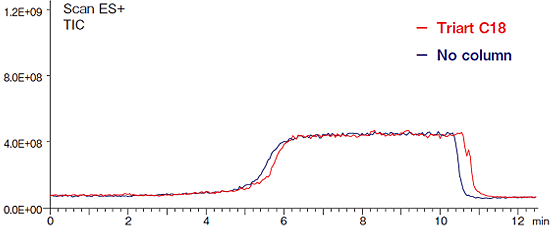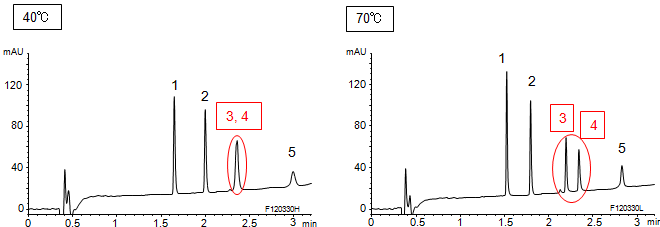YMC-Triart C18 offers outstanding chemical and physical durability over a wide pH range at high temperatures.
As erythromycins are known to be easily degraded under acidic (pH < 6.5) conditions, higher pH is preferable. In addition, higher temperatures tend to show better peak shape. The enhanced chemical durability of Triart C18 enables highly reproducible analysis at high pH and high temperature.
Analysis of erythromycins at pH 7.9, 70ºC


1. Erythromycin
2. Erythromycin ethylsuccinate
3. Erythromycin estolate
| Column | YMC-Triart C18 (3 μm, 120Å), 50 X 2.0 mmI.D. |
|---|---|
| Eluent | 20 mM KH2PO4-K2HPO4 (pH 7.9)/acetonitrile/methanol (40/45/15) |
| Flow rate | 0.2 mL/min |
| Temperature | 70ºC |
| Detection | UV at 210 nm |
Using 100% aqueous mobile phase with conventional C18 columns generally shows poor performance (retention and peak shape) owing to low surface hydration caused by repulsion between aqueous mobile phase and the hydrophobic bonded phase. Triart C18 is designed to retain both moderate hydrogen bonding capacity and hydrophobicity on the surface by optimizing the bonding density of the C18 phase. Its versatility makes it ideal for a first choice ODS column, and is also applicable to the analysis of polar compounds under 100% aqueous mobile phase conditions.
In the experiment illustrated here, Triart C18 shows stable retention of organic acids, even after stopping the pump.

1. Oxalic acid
2. Tartaric acid
3. Glycolic acid
4. Formic acid
5. L-Malic acid
6. Malonic acid
7. Lactic acid
8. Acetic acid
9. Maleic acid
10 . Citric acid
11 . Succinic acid
12 . Fumaric acid
13 . Acrylic acid
14 . Propionic acid
| Column | YMC-Triart C18 (3 μm, 120 Å), 150 X 3.0 mmI.D. |
|---|---|
| Eluent | 20 mM H3PO4 |
| Flow rate | 0.425 mL/min |
| Temperature | 37ºC |
| Detection | UV at 220 nm |
YMC-Triart C18 can tolerate larger injection volumes of samples containing solvents that have a strong eluting ability (e.g., acetonitrile), while giving better peak shapes than conventional columns. This can be important for samples pre-treated with higher concentrations of organic solvent, crude reaction samples, and samples with poor solubility.
Influence of injection volume on peak shape



| Column | 5 μm, 50 X 2.0 mmI.D. or 2.1 mmI.D. |
|---|---|
| Eluent | A) water/formic acid (100/0.1) B) acetonitrile/formic acid (100/0.1) 5%B (0-0.5 min), 5-100%B (0.5-2.5 min) |
| Flow rate | 0.4 mL/min |
| Temperature | 40ºC |
| Detection | UV at 275 nm |
On the Triart C18 column, very low levels of bleeding (leaching) are achieved due to improvements of the production procedure and product stability. The background noise of Triart C18 on LC/MS (TIC) is almost the same as that of a blank run with no column. These results prove that there is little bleeding from the Triart C18 column. Very low background noise and a high S/N ratio are expected on Triart columns, even with high-sensitivity detectors.
Bleed test by LC/MS

| Column | 5 µm, 50 X 2.0 mmI.D. |
|---|---|
| Eluent | A) water/formic acid (100/0.1) B) acetonitrile/formic acid (100/0.1) 5%B (0-1 min), 5-100%B (1-5 min), 100%B (5-10 min), 100-5%B (10-10.1 min), 5%B (10.1-12.5 min) |
| Flow rate | 0.4 mL/min |
| Temperature | 40ºC |
| Detection | ESI positive, TIC (Mass Range: 50-1000) |
Changing the column temperature will provide selectivity change as well as peak shape improvement. YMC-Triart C18, which offers excellent durability even under an elevated temperature condition, is effective for the separation of peptides and proteins.

| Column | YMC-Triart C18 (1.9 μm, 120 Å), 50 X 2.0 mmI.D. |
|---|---|
| Eluent | A) water/TFA (100/0.1) B) acetonitrile/TFA (100/0.1) 10-80%B (0-5 min) |
| Flow rate | 0.4 mL/min |
| Detection | 220 nm |